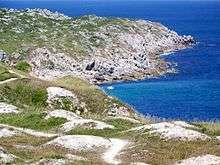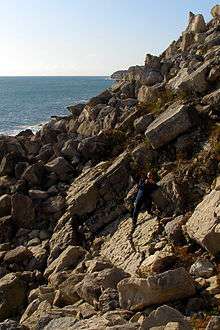The Great Southwell Landslip


The Great Southwell Landslip occurred on the Isle of Portland, Dorset, England; along part of the Jurassic Coast in 1734. Named after Portland's southerly village Southwell, the landslip occurred between Durdle Pier and Freshwater Bay, a distance of 1 1/2 miles (2 km). It remains Britain's second largest recorded historical landslide.[1]
Background
The landslip occurred as the cracks and gullies within the cliffs of Portland allow rain water to easily percolate down through the layers of Purbeck Beds, Portland Limestone and Portland Sand to the underlying impermeable Kimmeridge Clay below. Because the island tilts to the south and the east, caused by the uplifting process, the water collects at the lowest points.[1][2] Creating Church Ope Cove in the process,[3] the effect on the toppled east coast remains today following the landslip.[4][5]
The landslip caused Portland's parish church St Andrew's Church at Church Ope Cove to be abandoned after it was in danger of falling over the cliff completely. This event caused a large section of the graveyard to slip down the cliff. Following the 1734 landslip, a decision was made, with a survey of the old church finding that repairs would be at least half the cost of a new building. This led to the church being closed and partly demolished in July 1756. Much of the stone was taken for use in local domestic dwellings. St George's Church was soon built at Reforne between 1754 and 1766, near Easton village, to replace the church.[6]
Since the landslip, the area south of Church Ope Cove has been given the local name of Southwell Landslips. It is in this area that between the main road and the sea, the cliff face has been subject to extensive quarrying as well as landslips which have tilted huge masses of rocks at odd angles. It was from this part of the coastline that much of Portland's raw sewerage once poured into the sea from an exposed pipe, before an expensive scheme was completed which involved taking all Portland's sewerage and pumping it to Weymouth.[7] In the north-eastern corner of Coombefield is the working Pennsylvania Quarry, which has existing wildlife value. This site provides a stepping stone between the Southwell Landslip area, which is to be a new nature reserve, created as part of a housing development north of Weston Road and to the south-east of Perryfields, and the existing Perryfields Butterfly Reserve and SNCI.[8]
References
- 1 2 "Quick facts about the Jurassic Coast". Jurassiccoastline.com. Retrieved 2016-01-09.
- ↑ "Quick facts about the Jurassic Coast". Jurassiccoastline.com. Retrieved 2016-01-09.
- ↑ (PDF) https://web.archive.org/web/20130329152838/http://jurassiccoast.org/downloads/jurassic_coast_by_boat.pdf. Archived from the original (PDF) on March 29, 2013. Retrieved July 13, 2013. Missing or empty
|title=(help) - ↑ http://www.southampton.ac.uk/~imw/jpg/2Pt-eastcoast-topple.jpg
- ↑ "Geology of the Isle of Portland, Dorset by Ian West". Southampton.ac.uk. 2012-10-13. Retrieved 2013-07-13.
- ↑ Anthony Houghton (2012-03-31). "Church Ope Cove and Penn's Weare - Information & Photographs". Strolling Guides. Retrieved 2016-01-09.
- ↑ "695705". Geoffkirby.co.uk. Retrieved 2013-07-13.
- ↑
Coordinates: 50°31′48″N 2°26′14″W / 50.5301°N 2.4373°W